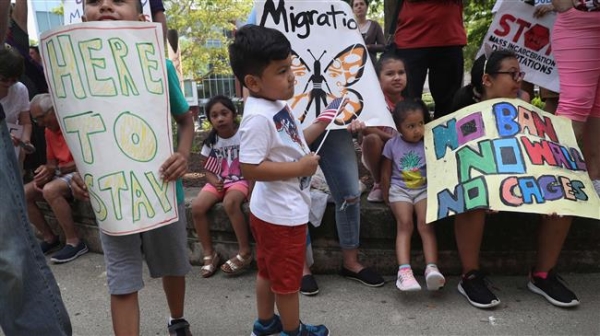
CALIFORNIA—(ENEWSPF)—July 19, 2018
By: Christina Jewett and Shefali Luthra
The Trump administration has summoned at least 70 children under 1 year old to immigration court for their own deportation proceedings since Oct. 1, according to new Justice Department data provided exclusively to Kaiser Health News.
These children, who may be staying with a sponsor or in a foster care arrangement, need frequent touching and bonding with a parent and naps every few hours, and some are of breastfeeding age, medical experts say. They’re unable to speak and still learning when it’s day versus night.
“For babies, the basics are really important. It’s the holding, the proper feeding, proper nurturing,” said Shadi Houshyar, who directs early childhood and child welfare initiatives at advocacy group Families USA.
The number of infants under age 1 involved has been rising — up threefold from 24 infants in the fiscal year that ended last Sept. 30, and 46 infants the year before.
The Justice Department data show that a total of 1,500 “unaccompanied” children, from newborns to age 3, have been called in to immigration court since Oct. 1, 2015.
Roughly three-fourths of the children involved are represented by a lawyer and they have to make their case that they should stay in the United States.
Officials who review such deportation cases say most children under 1 cross the border with a parent and their deportation cases proceed together.
But some of the infants were deemed “unaccompanied” only after law enforcement separated them from their parents during the Trump administration’s “zero-tolerance” immigration policy. The children were sent to facilities across the U.S. under the supervision of the Department of Health and Human Services.
“This is to some extent a … crisis of the creation of the government,” said Robert Carey, who previously headed the Office of Refugee Resettlement, which takes custody of unaccompanied minors. “It’s a tragic and ironic turn of events.”
Younger children are also considered unaccompanied if they enter the U.S. with an older family member who is not yet 18. The data do not clarify which children arrived that way or which were separated from their parents.
The Justice Department did not respond to a request for further data about where the children are housed. They could be in a foster care home, at a group home, with a relative or sponsor or reunited with a parent. HHS, which operates the refugee resettlement office, did not provide comment by publication time.
In previous statements, the government has argued that separation — and its consequences — are unfortunate but unavoidable under the law.
“There is a surefire way to avoid separation from your children. Present yourself legally … or stay back at your home country, and go through the process others do,” HHS Secretary Alex Azar said on a media call earlier this month. “None of us want children separated from their parents. I want no children in our care and custody.”
The number of unaccompanied children called in to court since Oct. 1, 2015, swells to 2,900 if kids up to 5 are included. The total will rise between now and Sept. 30, when the fiscal year ends, noted Susan Long, a statistician at Syracuse University and director of TRAC, a repository of immigration and federal court data. There’s also an ongoing backlog in entering the data.
In June, a district judge in San Diego ordered the government to reunify families within a month, specifically directing them to unite children younger than 5 with parents by July 10.
HHS reunited about half of those children by July 12 — 57 out of 103. Others, the government said, could not be placed with a parent, citing in some cases “serious criminal history” or parents currently being in jail.
In 12 cases, those children’s parents had already been deported. In another, the government had failed to figure out where the child’s parent was located, and in another, the parent had a “communicable disease,” HHS said.
The Department of Homeland Security, which issues the court orders, also did not respond to a request for comment.
In the removal cases, children have no right to an appointed lawyer, but rather to a list of legal aid attorneys that the child’s current caregiver can contact.
And young children rarely know the details of why they fled their home country, especially without a parent present, noted Eileen Blessinger, a Virginia-based immigration lawyer who has been aiding parents.
“Think about it as a parent. You’re not going to tell your child they might be killed, right?” she said. “A lot of the kids don’t know.”
Immigration court, which is an administrative unit of the Department of Justice, is different from typical courts. It handles “respondents” who may be too young to speak, but has no social workers or legal remedies focused on the best interest of a child, said Lenni Benson, a New York Law School professor and founder of the Safe Passage Project, which provides legal services to migrant youth.
“An immigration judge has no discretion,” Benson said. “There’s no ‘I’m hearing the mom wants the kid, I’m going to decide what’s best,’” she said. Instead, “it’s ‘the government has charged you with being removable from the U.S. Do you have evidence to show you have a right to be here?’”
Benson recounted being in immigration court in 2014 when a judge asked for a crying baby to be removed from the courtroom. She said she paused to inform the judge that the baby was the next respondent on the docket — and asked that the child’s grandmother stand in.
The stakes for the babies, and any migrant fleeing violence, are high, said Paul Wickham Schmidt, a former immigration judge who retired in 2016 after 13 years on the bench in Arlington, Va.
“Final orders of deportation have consequences,” he said. “For something that has a very serious result, this system has been described as death penalty cases in traffic court.”
Ashley Tabaddor, president of the National Association of Immigration Judges and a judge specializing in juvenile cases in Los Angeles, acknowledged that the administration narrowed a directive on how much judges can assist juveniles in court. Still, she said, judges do their best to ensure that young children get a fair hearing.
Justice Department data show that asylum denials are at a nearly 10-year high at 42 percent, and the Associated Press reported that the administration has raised the bar for making a successful case.
At the same time, children can be strapped for resources, Blessinger said.
She described one client whose 7-year-old daughter received legal support from a New York-based charity. Even in that case, she said, the organization acted simply as a “friend of the court” — rather than a full-fledged attorney — requesting delays in proceedings until the child and mother could be reunited. That finally happened Tuesday night, she said.
“It’s the saddest experience. These people are not going to be recovering anytime soon,” she said. “The parents are crying even after they’re reunited.”
KHN’s coverage of children’s health care issues is supported in part by the Heising-Simons Foundation.
Source: www.khn.org








